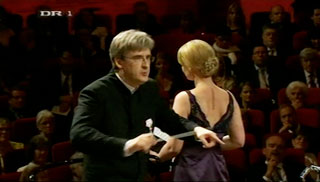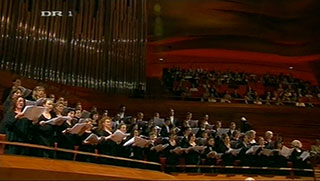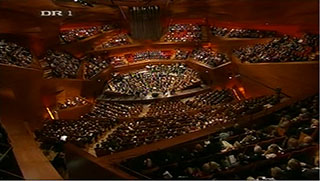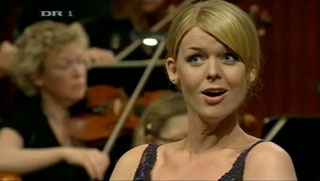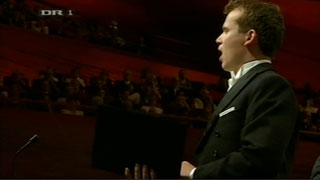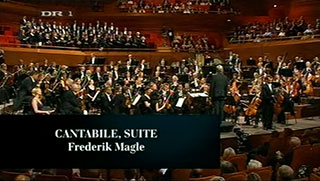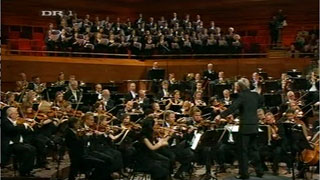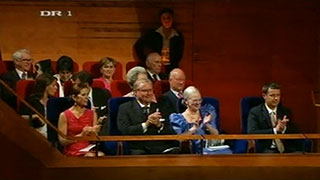Free MP3 and lossless audio excerpts from the first performance of the symphonic suite Cantabile's 2nd and 3rd movements on June 10th (2009) in the Copenhagen Concert Hall at the royal gala concert celebrating the 75th birthday of H.R.H. Henrik, the Prince Consort of Denmark.
First, excerpts from the second symphonic poem (2nd movement) from Cantabile; The »Cortège & Danse Macabre« (Procession and Dance of Death - or in this case perhaps more appropriately "Dance of the Dead". See the text below). Dark music, sometimes ominous, yet also with glimpses of tragic humor. The music depicts a procession of the dead - dancing. But they don't know they are dead, they don't know where, or even who, they are. And yet they are dancing, dancing towards the inevitable, their grave, the eternal.
Choose download format - MP3, FLAC, Apple Lossless, or uncompressed WAV (Select MP3 for smaller file size and maximum compatibility or FLAC/Apple Lossless/WAV (Info) for highest sound quality):
• Click here to download a large excerpt from »Cortège & Danse Macabre« (MP3)
(bar 100-280, 6:36 min., 15.9 MB, 320 kbps MP3 format)
Or click either of the following links to download the same excerpt in "lossless" formats (full 44.1KHz/16bit CD quality):
•• Cortège & Danse Macabre (WAV, 69.9 MB) •• Cortège & Danse Macabre (FLAC, 34.0 MB) •• Cortège & Danse Macabre (Apple Lossless, 34.4 MB)
---
• Click to download 3 smaller additional excerpts from the beginning of »Cortège & Danse Macabre« (MP3)
(2:32 min., 3.5 MB, 192 kbps MP3 format)
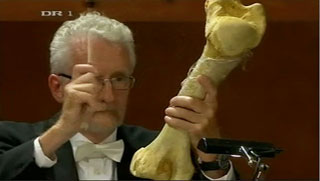
(This 80-years old Giraffe Bone can be heard at 1:27 in the
larger excerpt of the Danse Macabre. The use of a real bone
is specifically written in the score.
I've blogged about the quest for the bone here)
Secondly, an excerpt from the third and final symphonic poem (3rd movement) from the Cantabile suite; The »Carillon«. A "bell-like" theme is heard throughout the movement. «Carillon« begins with conflicting emotions; the luring - sometimes joyous, sometimes sentimental - yet simple hymnic melody of "L'Angelus" is contrasted with the brutality and complexity of reality (read the poem below).
The second half, which is heard in the excerpt, is based on the poem "Lacrymae mundi" (Tears of the world). It begins with a flowing choir, building up to full orchestra, and then concludes the whole work, returning to the theme of the first movement "Souffle le vent" at the very end.
Choose download format - MP3, FLAC, Apple Lossless, or uncompressed WAV:
• Click here to download an excerpt from »Carillon« (MP3)
(2:50 min., 6.8 MB, 320 kbps MP3 format)
Or select a "lossless" format:
•• Carillon (WAV, 30.1 MB) •• Carillon (FLAC, 16.9 MB) •• Carillon (Apple Lossless, 17.0 MB)
40 seconds into the following excerpt a passage begins in which you can hear the basses of the choir descent to the A below the bass-clef, one of the deepest notes ever written in work for choir and orchestra:
• Click here to download a small additional excerpt from »Carillon« (MP3)
(0:51 min., 2.1 MB, 320 kbps MP3 format)
• Click here to download a small additional excerpt from »Carillon« (WAV)
(0:51 min., 9 MB, uncompressed WAVE format)
The music is performed by The Danish National Symphony Orchestra (DR SymfoniOrkestret) and Choir, conducted by Thomas Dausgaard.
Soloists are:
Ina Kringlebotn, soprano (»Carillon«)
Erlend Tyrmi, baritone (»Danse Macabre« and »Carillon«)
Frederik Magle, piano (»Carillon«)
»Souffle le vent«, the first movement of the »Cantabile« suite was given its premiere performance in 2004. MP3 Excerpts of »Souffle le vent« are available for download here.
The orchestration/instrumentation of the Cantabile Suite:
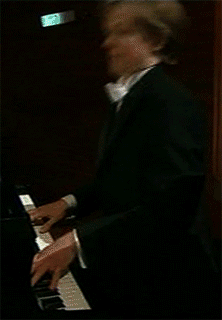
Frederik Magle
More still pictures:
The »Cortège & Danse Macabre« and »Carillon« from the symphonic suite »Cantabile« is copyright © Frederik Magle. Please do not hotlink to the audio files without posting a link to this page (or magle.dk) as well. The music has been uploaded to this site for free download with the consent of the copyright holders and in accordance with Danish and international copyright law.
____________
More music:
List of Classical Music Downloads by Frederik Magle | "The Hope" for brass band, choir, organ and percussion | Dark Classical Music Downloads
First, excerpts from the second symphonic poem (2nd movement) from Cantabile; The »Cortège & Danse Macabre« (Procession and Dance of Death - or in this case perhaps more appropriately "Dance of the Dead". See the text below). Dark music, sometimes ominous, yet also with glimpses of tragic humor. The music depicts a procession of the dead - dancing. But they don't know they are dead, they don't know where, or even who, they are. And yet they are dancing, dancing towards the inevitable, their grave, the eternal.
Choose download format - MP3, FLAC, Apple Lossless, or uncompressed WAV (Select MP3 for smaller file size and maximum compatibility or FLAC/Apple Lossless/WAV (Info) for highest sound quality):
(bar 100-280, 6:36 min., 15.9 MB, 320 kbps MP3 format)
Or click either of the following links to download the same excerpt in "lossless" formats (full 44.1KHz/16bit CD quality):
•• Cortège & Danse Macabre (WAV, 69.9 MB) •• Cortège & Danse Macabre (FLAC, 34.0 MB) •• Cortège & Danse Macabre (Apple Lossless, 34.4 MB)
---
• Click to download 3 smaller additional excerpts from the beginning of »Cortège & Danse Macabre« (MP3)
(2:32 min., 3.5 MB, 192 kbps MP3 format)

(This 80-years old Giraffe Bone can be heard at 1:27 in the
larger excerpt of the Danse Macabre. The use of a real bone
is specifically written in the score.
I've blogged about the quest for the bone here)
Secondly, an excerpt from the third and final symphonic poem (3rd movement) from the Cantabile suite; The »Carillon«. A "bell-like" theme is heard throughout the movement. «Carillon« begins with conflicting emotions; the luring - sometimes joyous, sometimes sentimental - yet simple hymnic melody of "L'Angelus" is contrasted with the brutality and complexity of reality (read the poem below).
The second half, which is heard in the excerpt, is based on the poem "Lacrymae mundi" (Tears of the world). It begins with a flowing choir, building up to full orchestra, and then concludes the whole work, returning to the theme of the first movement "Souffle le vent" at the very end.
Choose download format - MP3, FLAC, Apple Lossless, or uncompressed WAV:
(2:50 min., 6.8 MB, 320 kbps MP3 format)
Or select a "lossless" format:
•• Carillon (WAV, 30.1 MB) •• Carillon (FLAC, 16.9 MB) •• Carillon (Apple Lossless, 17.0 MB)
40 seconds into the following excerpt a passage begins in which you can hear the basses of the choir descent to the A below the bass-clef, one of the deepest notes ever written in work for choir and orchestra:
• Click here to download a small additional excerpt from »Carillon« (MP3)
(0:51 min., 2.1 MB, 320 kbps MP3 format)
• Click here to download a small additional excerpt from »Carillon« (WAV)
(0:51 min., 9 MB, uncompressed WAVE format)
The music is performed by The Danish National Symphony Orchestra (DR SymfoniOrkestret) and Choir, conducted by Thomas Dausgaard.
Soloists are:
Ina Kringlebotn, soprano (»Carillon«)
Erlend Tyrmi, baritone (»Danse Macabre« and »Carillon«)
Frederik Magle, piano (»Carillon«)
[YOUTUBE]pk1_w5Qed3A[/YOUTUBE]
»Souffle le vent«, the first movement of the »Cantabile« suite was given its premiere performance in 2004. MP3 Excerpts of »Souffle le vent« are available for download here.
The orchestration/instrumentation of the Cantabile Suite:
3 flutes (3rd: Piccolo),
2 oboes (2nd: English Horn)
3 Clarinets
1 Bass Clarinet
2 Bassoons
1 Contra-Bassoon
4 Horns
3 Trumpets
3 Trombones
1 Contrabass Tuba
Timpani
3 Percussionists
Harp
Piano (3rd movement; »Carillon«)
Organ (2nd and 3rd movements; »Danse Macabre« and »Carillon«)
Soprano Soloist (1st and 3rd movements; »Souffle le vent« and »Carillon«)
Bass-Baritone Soloist
Mixed Choir/Chorus (S,S,A,A,T,T,B,B)
Strings
If you would like to hear the work in full, please let me know by private message or email.2 oboes (2nd: English Horn)
3 Clarinets
1 Bass Clarinet
2 Bassoons
1 Contra-Bassoon
4 Horns
3 Trumpets
3 Trombones
1 Contrabass Tuba
Timpani
3 Percussionists
Harp
Piano (3rd movement; »Carillon«)
Organ (2nd and 3rd movements; »Danse Macabre« and »Carillon«)
Soprano Soloist (1st and 3rd movements; »Souffle le vent« and »Carillon«)
Bass-Baritone Soloist
Mixed Choir/Chorus (S,S,A,A,T,T,B,B)
Strings

Frederik Magle
More still pictures:
The »Cortège & Danse Macabre« and »Carillon« from the symphonic suite »Cantabile« is copyright © Frederik Magle. Please do not hotlink to the audio files without posting a link to this page (or magle.dk) as well. The music has been uploaded to this site for free download with the consent of the copyright holders and in accordance with Danish and international copyright law.
____________
More music:
List of Classical Music Downloads by Frederik Magle | "The Hope" for brass band, choir, organ and percussion | Dark Classical Music Downloads
Last edited:

